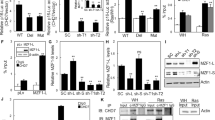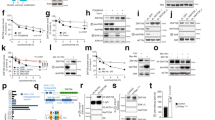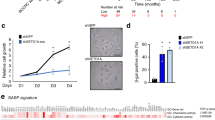Abstract
The reactivation of the INK4-ARF locus, which is epigenetically repressed by Polycomb proteins in healthy cells, is a hallmark of senescence. One mechanism of reactivating Polycomb-silenced genes is mediated by the epigenetic factor ZRF1, which associates with ubiquitinated histone H2A. We show that cells undergoing senescence following oncogenic Ras expression have increased ZRF1 levels, and that this binds to the p15INK4b, ARF and p16INK4a promoters. Furthermore, ZRF1 depletion in oncogenic Ras-expressing cells restores proliferation by preventing Arf and p16Ink4a expression, consequently bypassing senescence. Thus, ZRF1 regulates the INK4-ARF locus during cellular proliferation and senescence, and alterations in ZRF1 may contribute to tumorigenesis.
This is a preview of subscription content, access via your institution
Access options
Subscribe to this journal
Receive 50 print issues and online access
$259.00 per year
only $5.18 per issue
Buy this article
- Purchase on Springer Link
- Instant access to full article PDF
Prices may be subject to local taxes which are calculated during checkout






Similar content being viewed by others
References
Kim WY, Sharpless NE . The regulation of INK4/ARF in cancer and aging. Cell 2006; 127: 265–275.
Lowe SW, Sherr CJ . Tumor suppression by Ink4a-Arf: progress and puzzles. Curr Opin Genet Dev 2003; 13: 77–83.
Collado M, Serrano M . The power and the promise of oncogene-induced senescence markers. Nat Rev Cancer 2006; 6: 472–476.
Krimpenfort P, Ijpenberg A, Song JY, van der Valk M, Nawijn M, Zevenhoven J et al. p15Ink4b is a critical tumour suppressor in the absence of p16Ink4a. Nature 2007; 448: 943–946.
Kuilman T, Michaloglou C, Mooi WJ, Peeper DS . The essence of senescence. Genes Dev 2010; 24: 2463–2479.
Adams PD . Healing and hurting: molecular mechanisms, functions, and pathologies of cellular senescence. Mol Cell 2009; 36: 2–14.
Collado M, Serrano M . Senescence in tumours: evidence from mice and humans. Nat Rev Cancer 2010; 10: 51–57.
Gil J, Peters G . Regulation of the INK4b-ARF-INK4a tumour suppressor locus: all for one or one for all. Nat Rev Mol Cell Biol 2006; 7: 667–677.
Cruickshanks HA, Adams PD . Chromatin: a molecular interface between cancer and aging. Curr Opin Genet Dev 2011; 21: 100–106.
Maertens GN, El Messaoudi-Aubert S, Racek T, Stock JK, Nicholls J, Rodriguez-Niedenfuhr M et al. Several distinct polycomb complexes regulate and co-localize on the INK4a tumor suppressor locus. PLoS One 2009; 4: e6380.
Kia SK, Gorski MM, Giannakopoulos S, Verrijzer CP . SWI/SNF mediates polycomb eviction and epigenetic reprogramming of the INK4b-ARF-INK4a locus. Mol Cell Biol 2008; 28: 3457–3464.
Gil J, Bernard D, Martinez D, Beach D . Polycomb CBX7 has a unifying role in cellular lifespan. Nat Cell Biol 2004; 6: 67–72.
Bracken AP, Kleine-Kohlbrecher D, Dietrich N, Pasini D, Gargiulo G, Beekman C et al. The Polycomb group proteins bind throughout the INK4A-ARF locus and are disassociated in senescent cells. Genes Dev 2007; 21: 525–530.
Dietrich N, Bracken AP, Trinh E, Schjerling CK, Koseki H, Rappsilber J et al. Bypass of senescence by the polycomb group protein CBX8 through direct binding to the INK4A-ARF locus. EMBO J 2007; 26: 1637–1648.
Agger K, Cloos PA, Rudkjaer L, Williams K, Andersen G, Christensen J et al. The H3K27me3 demethylase JMJD3 contributes to the activation of the INK4A-ARF locus in response to oncogene- and stress-induced senescence. Genes Dev 2009; 23: 1171–1176.
Barradas M, Anderton E, Acosta JC, Li S, Banito A, Rodriguez-Niedenfuhr M et al. Histone demethylase JMJD3 contributes to epigenetic control of INK4a/ARF by oncogenic RAS. Genes Dev 2009; 23: 1177–1182.
Kotake Y, Zeng Y, Xiong Y . DDB1-CUL4 and MLL1 mediate oncogene-induced p16INK4a activation. Cancer Res 2009; 69: 1809–1814.
Simboeck E, Ribeiro JD, Teichmann S, Di Croce L . Epigenetics and senescence: Learning from the INK4-ARF locus. Biochem Pharmacol 2011; 82: 1361–1370.
Richly H, Rocha-Viegas L, Ribeiro JD, Demajo S, Gundem G, Lopez-Bigas N et al. Transcriptional activation of polycomb-repressed genes by ZRF1. Nature 2010; 468: 1124–1128.
Richly H, Di Croce L . The flip side of the coin: role of ZRF1 and histone H2A ubiquitination in transcriptional activation. Cell Cycle 2011; 10: 745–750.
Andrews PW . Retinoic acid induces neuronal differentiation of a cloned human embryonal carcinoma cell line in vitro. Dev Biol 1984; 103: 285–293.
Lois AF, Cooper LT, Geng Y, Nobori T, Carson D . Expression of the p16 and p15 cyclin-dependent kinase inhibitors in lymphocyte activation and neuronal differentiation. Cancer Res 55: 4010–4013 1995.
Thullberg M, Bartkova J, Khan S, Hansen K, Ronnstrand L, Lukas J et al. Distinct versus redundant properties among members of the INK4 family of cyclin-dependent kinase inhibitors. FEBS Lett 2000; 470: 161–166.
Freemantle SJ, Kerley JS, Olsen SL, Gross RH, Spinella MJ . Developmentally-related candidate retinoic acid target genes regulated early during neuronal differentiation of human embryonal carcinoma. Oncogene 2002; 21: 2880–2889.
Serrano M, Lin AW, McCurrach ME, Beach D, Lowe SW . Oncogenic ras provokes premature cell senescence associated with accumulation of p53 and p16INK4a. Cell 1997; 88: 593–602.
Zindy F, Quelle DE, Roussel MF, Sherr CJ . Expression of the p16INK4a tumor suppressor versus other INK4 family members during mouse development and aging. Oncogene 1997; 15: 203–211.
Malumbres M, Perez De Castro I, Hernandez MI, Jimenez M, Corral T, Pellicer A . Cellular response to oncogenic ras involves induction of the Cdk4 and Cdk6 inhibitor p15(INK4b). Mol Cell Biol 2000; 20: 2915–2925.
Shoji W, Inoue T, Yamamoto T, Obinata M . MIDA1, a protein associated with Id, regulates cell growth. J Biol Chem 1995; 270: 24818–24825.
Ferbeyre G, de Stanchina E, Querido E, Baptiste N, Prives C, Lowe SW . PML is induced by oncogenic ras and promotes premature senescence. Genes Dev 2000; 14: 2015–2027.
McConnell BB, Starborg M, Brookes S, Peters G . Inhibitors of cyclin-dependent kinases induce features of replicative senescence in early passage human diploid fibroblasts. Curr Biol 1998; 8: 351–354.
Lazarov M, Kubo Y, Cai U, Dajee M, Tarutani M, Lin Q et al. CDK4 coexpression with Ras generates malignant human epidermal tumorigenesis. Nature Medicine 2002; 8: 1105–1114.
Kemp CJ . Multistep skin cancer in mice as a model to study the evolution of cancer cells. Semin Cancer Biol 2005; 15: 460–473.
Maertens GN, El Messaoudi-Aubert S, Elderkin S, Hiom K, Peters G . Ubiquitin-specific proteases 7 and 11 modulate Polycomb regulation of the INK4a tumour suppressor. EMBO J 2010; 29: 2553–2565.
Matsumoto-Taniura N, Pirollet F, Monroe R, Gerace L, Westendorf JM . Identification of novel M phase phosphoproteins by expression cloning. Mol Biol Cell 1996; 7: 1455–1469.
Smith JC, Duchesne MA, Tozzi P, Ethier M, Figeys D . A differential phosphoproteomic analysis of retinoic acid-treated P19 cells. J Proteome Res 2007; 6: 3174–3186.
Adler AS, Sinha S, Kawahara TL, Zhang JY, Segal E, Chang HY . Motif module map reveals enforcement of aging by continual NF-kappaB activity. Genes Dev 2007; 21: 3244–3257.
Resto VA, Caballero OL, Buta MR, Westra WH, Wu L, Westendorf JM et al. A putative oncogenic role for MPP11 in head and neck squamous cell cancer. Cancer Res 2000; 60: 5529–5535.
Keyes WM, Wu Y, Vogel H, Guo X, Lowe SW, Mills AA . p63 deficiency activates a program of cellular senescence and leads to accelerated aging. Genes Dev 2005; 19: 1986–1999.
Gandarillas A, Watt FM . c-Myc promotes differentiation of human epidermal stem cells. Genes Dev 1997; 11: 2869–2882.
Dimri GP, Lee X, Basile G, Acosta M, Scott G, Roskelley C et al. A biomarker that identifies senescent human cells in culture and in aging skin in vivo. Proc Natl Acad Sci USA 1995; 92: 9363–9367.
Acknowledgements
We thank VA Raker for help in preparing the manuscript, and to the CRG Genomic Unit. This work was supported by grants from the Spanish ‘Ministerio de Educación y Ciencia’ (CONSOLIDER and BFU2010-18692), from the European Commission FP7 project 4DCellFate (277899), and from AICR (10-0177) to LDC. JDR was supported by grant SFRH/BD/15908/2005 from Foundation for Science and Technology (FCT) Portugal and is a fellow of the Graduate Program in Areas of Basic and Applied Biology (GABBA), University of Oporto, Portugal; LM was supported by a post-doctoral CRG-Novartis fellowship.
Author information
Authors and Affiliations
Corresponding author
Additional information
Supplementary Information accompanies the paper on the Oncogene website
Rights and permissions
About this article
Cite this article
Ribeiro, J., Morey, L., Mas, A. et al. ZRF1 controls oncogene-induced senescence through the INK4-ARF locus. Oncogene 32, 2161–2168 (2013). https://doi.org/10.1038/onc.2012.241
Received:
Revised:
Accepted:
Published:
Issue Date:
DOI: https://doi.org/10.1038/onc.2012.241
Keywords
This article is cited by
-
Intracellular HSP70L1 inhibits human dendritic cell maturation by promoting suppressive H3K27me3 and H2AK119Ub1 histone modifications
Cellular & Molecular Immunology (2020)
-
Silencing of ZRF1 impedes survival of estrogen receptor positive MCF-7 cells and potentiates the effect of curcumin
Tumor Biology (2016)
-
ZRF1 controls the retinoic acid pathway and regulates leukemogenic potential in acute myeloid leukemia
Oncogene (2014)
-
Functional conservation and divergence of J-domain-containing ZUO1/ZRF orthologs throughout evolution
Planta (2014)



